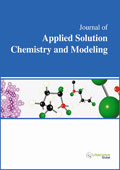jascm
|
Abstract: Numerous complexes between versatile derivatives of metalloporphyrins MP (with M being Mn, Co, Ni, Cu, Zn and Fe) and C60 have been synthesized and characterized recently. Favorable van der Waals attractions between the curved p-surface of the fullerene and the planar p-surface of MP assist in the supramolecular recognition, overcoming the necessity of matching a concave-shaped host with a convex-shaped guest structure. Recently, we reported the computational studies of the structures and electronic properties of the series of metalloporphyrins where all the four pyrrole nitrogen atoms are replaced with P-atoms, MP(P)4, M = Sc-Zn. Motivated by the numerous examples of the complex formation between regular planar or quasi-planar MP and C60, we computationally investigated possibility of the complex formation between two MP(P)4 species, ZnP(P)4 and NiP(P)4, and C60 without any linkers, using the CAM-B3LYP/6-31G* approach, both in the gas phase and with implicit effects from C6H6. We found that the binding energies in the MP(P)4-C60 complexes for these twoMP(P)4 compounds are relatively low, ca. 1-1.6 kcal/mol and ca. 5 kcal/mol for M = Zn and Ni, respectively. The ZnP(P)4 species was found to be noticeably distorted in the ZnP(P)4-C60 complex whereas NiP(P)4 inside the NiP(P)4-C60 complex essentially retained its bowl-like shape. Thus, we showed the possibility of the formation of complexes between MP(P)4 species and C60 without any linkers and showed dependence of the complex stability on the transition metal M. Further investigations are in progress. Keyword: Porphyrin-fullerene complexes, tetraphosphorus-metalloporphyrins, DFT, binding energies, NBO charges. |
|
Abstract: Improved understanding of water flow and solute transport through the unsaturated zone is important for the sustainable management of soils. As soils are complex and heterogeneous systems, quantification of the transport processes is difficult. More knowledge on the relationship between solute transport process, soil structure, hydrologic initial and boundary conditions, and observation scale is needed here.Modeling unsaturated flow and transport with mathematical or numerical methods is an important tool for predicting the infiltration and redistribution of soil water and the transport of solutes in the unsaturated zone. Flow and transport models are commonly used to support the decision making process in agricultural management, environmental impact assessment, toxic waste control, remediation design, and subsurface cleanup monitoring.The movement of contaminants through porou media describs by the combination of advection, diffusion-dispersion and chemical retardation.The most common model that describes solute transport by convection and dispersion is the convection-dispersion equation (CDE).This equation describes the change in concentration at any point along the flow path as a function of time. This paper is mainly dedicated to a discussion of basic processes for modelling of water flow and contaminant transport in saturated and unsaturated soils. After a brief description of the classical approach for simulating water flow and solute transport in porous media, issues related to water and solute trasport equation in soil. Keyword: Soil water flow and solute transfer, Breakthrough curves (BTCs), Pore water velocity, Dispersivity.
|
|
Abstract: In this article given the mathematical modeling of energy-intensive substances obtaining, which allows expanding the resource base, providing the possibility of using various binary hydrides in the process of aluminum hydride - AlH3 synthesis. Due to the absence of soluble hydride forms of binary hydrides of alkaline-earth (MH2) metals, it is necessary to carry out at least 4-6 steps of the process for the production of aluminum hydride. Polynomials for the programmed synthesis of AlH3 with autoinitiation have been developed. A programmed synthesis of aluminum hydride with autoinitiation was developed and implemented, which allows expanding the raw material base enabling the synthesis of other metal hydrides. |
|
Abstract: The solubility of atenolol (ATN) in some {ethanol (1) + water (2)} mixtures expressed in mole fraction at temperatures from 298.2 to 313.2 K was calculated from reported solubility values expressed in molarity scale. The van’t Hoff and Gibbs equations were used to calculate the respective apparent thermodynamic functions: Gibbs energy, enthalpy, and entropy of the dissolution processes. Non-linear enthalpy–entropy relationship was observed for this drug ATN in the plot of enthalpy vs. Gibbs energy of solution with negative slope in the composition region 0.00 £ w1 £ 0.20 but positive slope in the region 0.20 £ w1 £ 0.40. Beyond this composition, the behavior is more complex. Hence, the driving mechanism for ATN dissolution process is the entropy in water-rich mixtures and the enthalpy in mixtures 0.20 £ w1 £ 0.40. Furthermore, the preferential solvation of ATN by both solvents was analyzed by using the inverse Kirkwood-Buff integrals observing that this drug is preferentially solvated by water molecules in water-rich and also in ethanol-rich mixtures but preferentially solvated by ethanol molecules in mixtures 0.24 £ x1 £ 0.51. Keyword: Atenolol, (ethanol + water) mixtures, solubility, solution thermodynamics, preferential solvation. |
 Vapor-Liquid Equilibrium at Several Experimental Conditions of the Binary Mixtures Methyl Lactate with n-Alkanols - Pages 14-20 Vapor-Liquid Equilibrium at Several Experimental Conditions of the Binary Mixtures Methyl Lactate with n-Alkanols - Pages 14-20Rubén Ezquerra, Alberto Latorre, Najla Ben Mahdoui and Carlos Lafuente DOI: https://doi.org/10.6000/1929-5030.2018.07.03 Published: 24 September 2018 |
Abstract: In this contribution the vapor-liquid equilibrium of the binary mixtures formed by methyl lactate and the first four lineal alkanols has been determined at constant pressure (p = 101.325 kPa) and at constant temperature (T = 323.15 K). The results have been adequately correlated with the Wilson equation. The obtained data have been satisfactorily checked for thermodynamic consistency using the van Ness method. Furthermore, we have applied the UNIFAC method to predict the vapor-liquid equilibrium and compared these predictions with the experimental results. |

